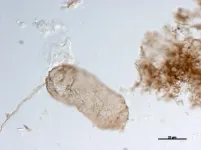(Press-News.org) Compounds that obstruct the "landing gear" of a range of harmful viruses can successfully protect against infection by the virus that causes COVID-19, a study published today and led by Dana-Farber Cancer Institute scientists shows. Based on the findings, researchers have launched a human clinical trial of one such compound made by chemically stabilizing a key coronavirus peptide.
If the compound, called a stapled lipopeptide, proves effective as a nasal spray in the trial, it could be the basis for a new drug modality to prevent or treat COVID-19, say the authors of the study, posted online today in the journal Nature Communications. Because such compounds foil a mechanism used by many types of viruses to enter and infect cells, stapled lipopeptides may also be effective against dangerous and potentially deadly viruses such as RSV, Ebola, and Nipah, as the authors also demonstrate in their study.
"Although vaccines, monoclonal antibodies, and small molecule drugs have played a crucial role in protecting people from life-threatening COVID-19 infection, there remains a critical gap in the treatment arsenal," says Loren Walensky, MD, PhD, Physician and Principal Investigator, Linde Program in Cancer Chemical Biology at Dana-Farber/Boston Children’s Cancer and Blood Disorders Center. He led the research with Gregory Bird, PhD, of Dana-Farber and Robert Davey, PhD, of Boston University’s National Emerging Infectious Diseases Laboratories (NEIDL).
“The constant evolution of the virus and the emergence of new variants has markedly decreased the effectiveness of immune-based approaches, requiring periodic reformulation of vaccines. What has been missing are fast-acting, easy-to-administer, and resistance-proof agents that can be used before or after exposure to the virus to directly prevent infection or reduce symptoms. Our study is an encouraging indication that stapled lipopeptides offer that potential,” Walensky added.
“It was exciting to see how these peptides, which work by jamming the gears of the virus infection machine, moved quickly from a basic idea on paper to being effective with the viruses and in real disease models,” said Robert Davey, PhD, Professor, Microbiology at Boston University’s NEIDL. “This was a great collaboration that started in the very first days of the pandemic when we wanted to work out a treatment for SARS-CoV-2 using the great biocontainment resources we have at Boston University. Our two labs worked very well together, and this is something we will continue to do in the future on other viruses that I work on like Ebola.”
Unlike mRNA vaccines, which are a form of immune-based therapy that provides delayed protection and also requires periodic administration due to viral mutation and/or waning immunity, the stapled lipopeptides developed by Walensky's lab act directly on SARS-CoV-2, the coronavirus responsible for COVID-19, interfering with its ability to infect healthy cells. Because this approach does not use the immune system as an intermediary, it is especially promising for people with weakened immune systems, either due to their disease or treatment with immunosuppressive agents, such as chemotherapy.
Walensky's lab has pioneered the development and application of stapled peptides for nearly 20 years. These unique agents consist of natural peptides – a stretch of amino acids in a defined sequence – whose bioactive structure is chemically stabilized by an installed “staple” and, in this case, further linked to a lipid, which is believed to help concentrate the stapled peptide at the site of viral infection – the membrane surface of the otherwise healthy cell. The new study shows that stapled lipopeptides are exceptionally stable, resisting extremes of temperature and chemical conditions, an important feature for persistence both inside and outside the body. The design strategy not only prevents peptide degradation in the body upon administration, but also remedies prior challenges with shipment and storage, such as the required cold chain for COVID-19 vaccines.
In 2010, Walensky's lab first developed double-stapled peptides that target the same key step in the process by which the human immunodeficiency virus (HIV) binds to, and then infects, human cells, causing AIDS. The stapled peptides mimicked the virus's "landing gear," a bundle of six coils or “helices” of the virus that comes together, enabling the virus to fuse with the membrane of the host cell. The therapeutic approach, known as fusion inhibition, prevents the virus from entering the cell to off-load its nucleic acid blueprint, which otherwise turns the cell into a virus-producing factory. The stapled peptide, which mimics one of the coiled regions, disrupts formation of the fusion apparatus, halting infection at its source.
In 2014, Walensky's team developed analogous stapled peptides targeting this same feature of the RSV virus, which can cause severe respiratory illness and even respiratory failure in the elderly and very young alike. They showed that administering the stapled peptide as a nose drop could prevent RSV infection in mice and also prevent the spread of established nasal infection from migrating to the lungs. When the COVID-19 pandemic broke out in early 2020, Walensky's lab promptly converted one of the coiled motifs of the SARS-CoV-2 six-helix bundle into a stapled peptide in an effort to develop a therapeutic for pre- and post-exposure prophylaxis.
"Remarkably, the viral peptide sequence that we use to block the fusion apparatus is 100% identical between SARS-CoV-2 and SARS1, which emerged as a deadly respiratory virus in 2003,” notes Walensky. He points out that, in contrast to the viral sequences that mutate frequently to evade immune-based therapies, the virus’s fusion sequences are rarely altered due to the critical role of six-helix bundle assembly in promoting viral infection. In cooperation with researchers expert in highly pathogenic viruses at the NEIDL, Walensky's team began developing dozens of stapled peptide fusion inhibitors for anti-viral testing, altering the location of the staple and the linker between the staple and the lipid, to determine which version worked best against the broadest spectrum of SARS-CoV-2 variants. Ironically, as the virus evolved to evade vaccines and monoclonal antibodies, the more effective the stapled lipopeptides became, owing to the essential nature of the fusion mechanism they target.
Then, in partnership with the laboratory of Richard Bowen, DVM, PhD, of Colorado State University and the newly formed Red Queen Therapeutics of Cambridge, Massachusetts that licensed the Dana-Farber technology, the Walensky lab began testing the inhibitors in hamsters. The studies evaluated a lead stapled lipopeptide as a preventive and therapeutic agent. The animals were randomly selected to receive an inhibitor before and/or after nasal inoculation with SARS-CoV-2.
The results were very encouraging, Walensky remarks. The animals in each group that received the inhibitor maintained their weight, an indication that they remained well despite viral exposure. Examination of their noses showed a relative drop in viral titers compared to the untreated control group and evaluation of their lung tissue found that the animals were significantly protected from severe pneumonia, a common complication of COVID-19.
"Similar to what we saw with RSV, nasal treatment with a stapled peptide fusion inhibitor – even if given after inoculation with SARS-CoV-2 – prevented the infection from adversely affecting the lungs and causing severe disease," Walensky comments.
A second set of studies explored whether the inhibitors could help reduce transmission of the virus from one hamster to another. Again, the results were encouraging. "Animals that weren't treated consistently lost weight. Those that received treatment, either before or after exposure to an infected hamster, preserved their weight," Walensky notes. Correspondingly, viral loads in the noses and lungs of treated animals were lower than in untreated animals.
The fact that many viruses with pandemic potential rely on the six-helix bundle to enter and infect cells suggests that stapled lipopeptides developed by Walensky's lab can be adapted to block or reduce infection by other viruses “on demand.”
“Red Queen Therapeutics was founded on the conviction that this novel technology from the Walensky lab would be broadly applicable in successfully combating viral threats, using a pre- and post-exposure prophylaxis paradigm, and COVID presents a proving ground as well as an important opportunity in its own right,” said Ron Moss, M.D., CEO of Red Queen Therapeutics. “We are excited to validate data in this publication with our human trials in SARS-CoV-2 now under way and anticipate having data to share later this quarter,” he added.
"This approach has the potential to fill an important gap in our arsenal against COVID-19 and other viruses that cause severe respiratory and hemorrhagic diseases," Walensky relates. "Imagine being able to protect yourself from COVID-19 or other disruptive respiratory viruses with a simple nasal spray that you could use to avoid infection at a large gathering or after exposure to a close contact who turns out to test positive for SARS-CoV-2. That is the promise this work holds, not only for otherwise healthy individuals, but especially for immunocompromised patients who remain most at risk of severe infection. As a Dana-Farber chemical biology lab that specializes in studying mechanisms of cancer chemoresistance in children, my group has also been interested in tackling the secondary causes of morbidity and mortality in our patients, and that includes life-threatening infections by treatment-resistant bacteria and viruses.
The research was supported by the Dana-Farber Cancer Institute, a grant from the Massachusetts Consortium on Pathogen Readiness and the National Institutes of Health to the NEIDL, and the Pre-clinical Services Program of the National Institute for Allergy and Infectious Diseases, which funded in part the animal testing performed at Colorado State University.
END
Novel compound protects against infection by virus that causes COVID-19, preliminary studies show
2024-01-05
ELSE PRESS RELEASES FROM THIS DATE:
Speech Accessibility Project begins recruiting people with ALS
2024-01-05
The Speech Accessibility Project has expanded its recruitment and is inviting U.S. and Puerto Rican adults living with amyotrophic lateral sclerosis to participate.
Those interested in participating can sign up online.
Funded by Big Tech companies Amazon, Apple, Google, Meta, and Microsoft, the University of Illinois Urbana-Champaign aims to train voice recognition technologies to understand people with diverse speech patterns and disabilities.
The project began recruiting people with Parkinson’s disease last ...
UofL study shows nicotine in e-cigarettes may not be harmless, as some claim
2024-01-05
With the start of a new year, smokers and vapers may have resolved to quit or cut back on the habit to improve their health. They may want to use caution, however, if their strategy involves switching from cigarettes to e-cigarettes, considered by some to be a less harmful alternative.
A new study from the University of Louisville shows the nicotine in certain types of e-cigarettes may be more harmful than others, increasing risk for irregular heartbeat, or heart arrhythmias.
A popular claim is that nicotine in ...
Maternal diabetes and overweight and congenital heart defects in offspring
2024-01-05
About The Study: This study of 620,000 children found that maternal type 1 diabetes was associated with increased risk for most types of congenital heart defects in offspring, while obesity and overweight were associated with increased risk for complex defects and outflow tract obstruction and decreased risk for ventricular septal defects. These different risk profiles of type 1 diabetes and overweight and obesity may suggest distinct underlying teratogenic mechanisms.
Authors: Riitta Turunen, M.D., Ph.D., and Emmi Helle, M.D., ...
Evaluation of changes in prices and purchases following implementation of sugar-sweetened beverage taxes across the US
2024-01-05
About The Study: Sugar-sweetened beverage (SSB) taxes in Boulder, Colorado; Philadelphia, Oakland, San Francisco, and Seattle led to substantial, consistent declines in SSB purchases following price increases associated with those taxes. Scaling SSB taxes nationally could yield substantial public health benefits.
Authors: Scott Kaplan, Ph.D., of the U.S. Naval Academy in Annapolis, Maryland, is the corresponding author.
To access the embargoed study: Visit our For The Media website ...
The evolution of photosynthesis better documented thanks to the discovery of the oldest thylakoids in fossil cyanobacteria
2024-01-05
Researchers at the University of Liège (ULiège) have identified microstructures in fossil cells that are 1.75 billion years old. These structures, called thylakoid membranes, are the oldest ever discovered. They push back the fossil record of thylakoids by 1.2 billion years and provide new information on the evolution of cyanobacteria which played a crucial role in the accumulation of oxygen on the early Earth. This major discovery is presented in the journal Nature.
Catherine Demoulin, Yannick Lara, Alexandre Lambion and Emmanuelle Javaux from the Early Life Traces & Evolution laboratory of the Astrobiology Research ...
Hypertension's hidden hand: pressure-driven foam cell formation revealed as key driver of arterial disease, paving the way for new therapies
2024-01-05
A new study in Advanced Science unlocks the secrets of how high blood pressure (hypertension) fuels the progression of arterial disease. Led by Professor Thomas Iskratsch, Professor of Cardiovascular Mechanobiology & Bioengineering at Queen Mary University of London, the research team exposes a novel mechanism by which elevated pressure transforms muscle cells in the arterial wall into "foam cells" – the building blocks of plaque buildup that cripples arteries.
The study focuses on vascular smooth muscle cells (VSMCs), the workhorses responsible for maintaining blood vessel tone and flow. Under ...
NRL researchers receive Defense Manufacturing Technology Achievement Award
2024-01-05
WASHINGTON – U.S. Naval Research Laboratory (NRL) researchers, Kevin Cronin and Drew Rodgers, receive Technology Achievement Award for Lightweight Hydrogen Fuel Cells for Unmanned Aerial Systems (UAS) research efforts at Defense Manufacturing Conference held in Nashville, Tenn., Dec. 11, 2023.
The Department of Defense (DOD) has a critical need for increased power and endurance for persistent Intelligence, Surveillance and Reconnaissance (ISR) and transmission of radio frequency (RF) sources for communications and targeting.
“It ...
Applications open for School of Advanced Science on Technology and Innovation Strategies and Policies for Economic Development
2024-01-05
The São Paulo Advanced School on Technology & Innovation Strategies and Policies for Economic Development will be held from June 24 to July 05, 2024, at the University of Campinas (UNICAMP) in São Paulo state, Brazil.
Reporters are invited to register for the scientific sessions and short courses, which will present state-of-art science and results of new research.
The School provides an opportunity to learn about and debate recent developments in the economics of technological change and in science, technology and innovation (ST&I) policy studies. The programme comprises numerous seminars, intensive courses, and roundtable discussions focusing ...
Ancestors of primates lived in pairs
2024-01-05
A study carried out by CNRS1 scientists working with an international team has revealed that around 70 million years ago, when dinosaurs existed, the ancestors of primates most commonly lived in pairs. Only 15% of them opted for a solitary lifestyle. This discovery — that our ancestors adopted variable forms of social organization — challenges the hitherto commonly accepted hypothesis that at the time of dinosaurs, the ancestors of primates lived alone, and that pair living evolved much later. Most likely, pair living offered significant benefits, such as easier reproduction and reduced costs of thermoregulation by huddling in pairs.
While several studies have already been conducted ...
Mysterious missing component in the clouds of Venus revealed
2024-01-05
What are the clouds of Venus made of? Scientists know it’s mainly made of sulfuric acid droplets, with some water, chlorine, and iron. Their concentrations vary with height in the thick and hostile Venusian atmosphere. But until now they have been unable to identify the missing component that would explain the clouds’ patches and streaks, only visible in the UV range.
In a new study published in Science Advances, researchers from the University of Cambridge synthesised iron-bearing sulfate minerals that are stable under the harsh chemical conditions in the Venusian clouds. Spectroscopic analysis revealed that a combination of two minerals, rhomboclase and acid ferric ...


